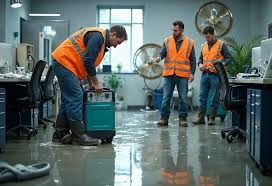
One of the most devastating factors to homes and businesses is water damage. Without immediate treatment, water infiltration from flooding, burst pipes, or leaks can cause structural damage, mold growth, and health problems. Water remediation removes water and restores the region. Employing the right remediation techniques is critical to controlling damage and minimizing costly repairs.
In this article, we explore the top techniques used in water remediation that help property owners recover efficiently while protecting the integrity of their buildings and health of occupants.
Immediate Water Extraction
The cornerstone of any successful water remediation effort is immediate water extraction. More harm can result from water sitting in a building longer. Extraction involves removing standing water as quickly as possible using powerful pumps, wet vacuums, and specialized suction equipment. This step is crucial because it reduces moisture levels, prevents structural decay, and inhibits mold and bacteria growth.
Professionals carefully assess the type of water—clean, gray, or black water—before extraction to determine safety precautions and disposal methods. Speed and thoroughness at this stage can significantly reduce restoration time and costs.
Thorough Drying And Dehumidification
After extracting visible water, the next vital step is drying and dehumidifying the affected areas. Water can seep into floors, walls, insulation, and furniture, making it essential to remove all residual moisture. Specialized industrial dehumidifiers and air movers circulate dry air to absorb trapped moisture and accelerate evaporation.
Proper drying prevents secondary damage like swelling, warping, and mold proliferation. Technicians monitor humidity and moisture levels continuously using moisture meters to ensure the environment returns to safe and stable conditions.
Structural Cleaning And Sanitization
Water damage often leaves behind contaminants, especially if the source is floodwater or sewage. After drying, the affected surfaces and materials require cleaning and sanitization. This process involves removing dirt, debris, and harmful microorganisms to restore a safe living or working environment.
Cleaning techniques vary based on the materials involved. Porous items like carpets or drywall may need specialized cleaning solutions or disposal if irreparably damaged. Many surfaces are coated with antimicrobials to prevent mold and bacteria growth.
Mold Prevention And Remediation
Mold growth from water damage is widespread and harmful. Even after drying, mold spores can thrive in hidden damp areas, posing serious health risks such as respiratory issues and allergies. Effective water remediation must include proactive mold prevention and, when necessary, mold remediation.
This technique involves thorough inspection for mold presence, removal of contaminated materials, and treatment of surfaces with mold inhibitors. Professionals also focus on maintaining proper ventilation and humidity control post-restoration to prevent mold recurrence.
Controlled Demolition And Repair
In cases of severe water damage, certain building materials may be compromised beyond repair. Controlled demolition involves safely removing damaged drywall, flooring, or insulation to prevent further contamination or structural issues.
This technique is carefully executed to minimize disruption while allowing access to affected areas for thorough remediation. Following demolition, repair, and reconstruction, restore the property’s structural integrity and appearance.
Use Of Advanced Technology
Modern water remediation relies heavily on advanced technology to detect moisture, monitor drying progress, and ensure comprehensive restoration. Thermal imaging cameras help identify hidden water pockets behind walls or under floors. Hygrometers and moisture sensors provide real-time data to guide the drying process.
Additionally, air scrubbers and ozone generators may be employed to improve air quality and eliminate odors caused by water damage. The integration of technology improves accuracy, speeds up remediation, and enhances outcomes.
Proper Waste Disposal And Environmental Compliance
Water remediation often generates waste, such as contaminated materials and cleaning residues. Proper disposal following environmental regulations is a critical technique to ensure that hazardous substances do not harm the environment or public health.
Reputable remediation companies adhere to local and federal guidelines when disposing of water-damaged debris, ensuring safety and compliance throughout the restoration process.
Documentation And Insurance Coordination
While not a physical remediation technique, meticulous documentation is essential for effective damage control. Detailed records of the damage, remediation steps, and materials used to support insurance claims and help property owners recover costs.
Many professional water remediation services offer assistance with insurance coordination, streamlining the claims process and reducing stress for clients.
Conclusion
Water remediation demands prompt action, specialized techniques, and advanced technology to control damage. Immediate water extraction, thorough drying, structural cleaning, mold prevention, and controlled demolition form the backbone of successful remediation efforts. When combined with precise monitoring and adherence to environmental standards, these techniques restore properties safely and efficiently.